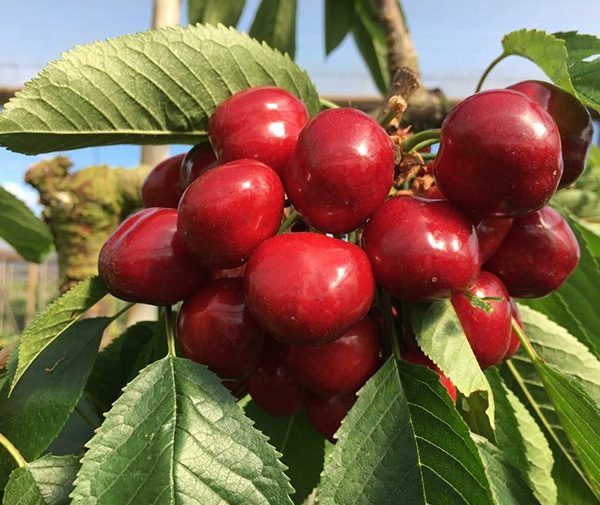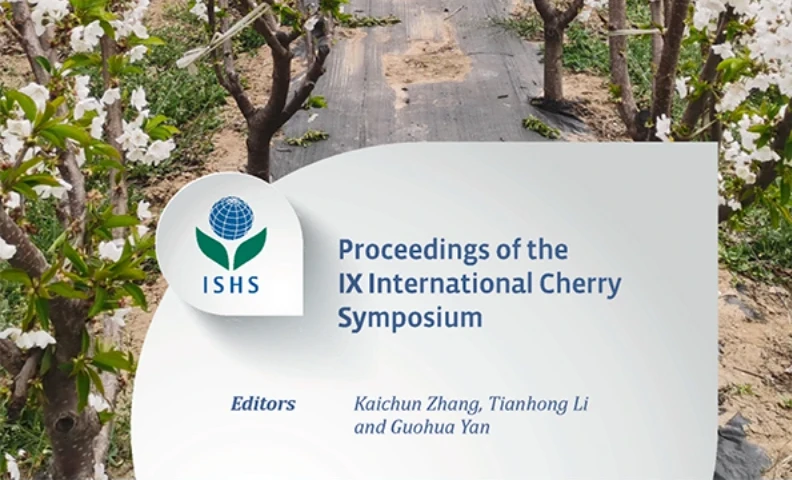The natural structure of the cherry tree makes it to grow to considerable heights. This means that achieving commercial production is not easy without interfering with the tree's growth.
The most commonly used strategy to control the vigor of the plant is through the use of dwarfing rootstocks, which, in turn, have allowed the development of new training systems. Thanks to this, the use of high-density training systems has increased in all cherry-growing regions worldwide.
Managing those trees requires regular renewal of branches and temporary fruiting shoots rather than permanent fruiting branches. As a result, trees allocate their nutritional resources to producing flowers and fruits rather than vegetative growth.
Training systems compared
 Figure 1. The Upright Fruiting Offshoot system
Figure 1. The Upright Fruiting Offshoot system
A study conducted at Ondokuz Mayıs University in Turkey between 2018 and 2020 compared the Vogel Central Leader (VC), Super Slender Axe (SSA), Upright Fruiting Offshoot (UFO), Tall Spindle Axe (TSA), and Kym Green Bush (KGB) training systems in terms of growth, yield, harvesting efficiency, and pruning time.
For this study, trees of the sweet cherry cultivar '0900 Ziraat' grafted onto Gisela 6 rootstock and planted in 2014 were considered. Among the five systems evaluated, the lowest tree volume was obtained from the UFO training system.
 Figure 2. The multi-axis pot-breeding system or KGB - Kym Green Bush
Figure 2. The multi-axis pot-breeding system or KGB - Kym Green Bush
During the 3-year trial period, the highest yield per hectare was achieved by the KGB, TSA, and UFO systems. The highest average harvesting efficiency was achieved by the KGB (36.5 kg h⁻¹) and UFO (36.1 kg h⁻¹) systems, and the lowest by the SSA system (22.1 kg h⁻¹).
Labor efficiency and pruning
Among the training systems, the shortest pruning times (both winter and summer) were achieved by the UFO system. As a result, these high-density training systems make harvesting and pruning easier and reduce the required labor hours.
 Figure 3. The centre-axis breeding system or SSA - Super Slender Axe
Figure 3. The centre-axis breeding system or SSA - Super Slender Axe
The presence of vigorous shoots in the Vogel Central Leader system and other traditional methods for large trees highlights their limited applicability in increasingly efficient contexts, making modern high-density training systems like SSA, UFO, KGB, and TSA a more practical and efficient choice.
In this study, it was observed that the KGB, TSA, UFO, and SSA systems produced more per hectare than the VC system. However, it was also found that the yields were slightly lower compared to other cherry cultivars.
The limits of the '0900 Ziraat' cultivar
This situation can be observed in many parts of the world where cherry cultivation is carried out for the reasons mentioned above. One of the main reasons for the low yield in our experiment was the cultivar used.
 Figure 4. The TSA - Tall Spindle Axe breeding system, an evolution of the Central Leader system
Figure 4. The TSA - Tall Spindle Axe breeding system, an evolution of the Central Leader system
'0900 Ziraat,' known as Turkish cherry, is a high-quality cultivar. However, the issue of pollen incompatibility has not been fully resolved, and although it has been extensively studied, no good pollinator cultivars have been identified.
Moreover, in recent years, the use of the '0900 Ziraat' cultivar has begun to decrease. In conclusion, this study demonstrates that the new systems generally increase the speed of harvesting and pruning, and labor is used more efficiently in these systems.
Source:Soysal, D., Demirsoy, L., Doğan, D.E. et al. Training System Effect on Fruit Quality, Yield, Harvest Efficiency, Pruning Times and Growth in Sweet Cherries. Applied Fruit Science 67, 6 (2025). https://doi.org/10.1007/s10341-024-01238-x
Image source: Greg Lang. Growing Produce
Melissa Venturi
University of Bologna
Cherry Times - Tutti i diritti riservati
















